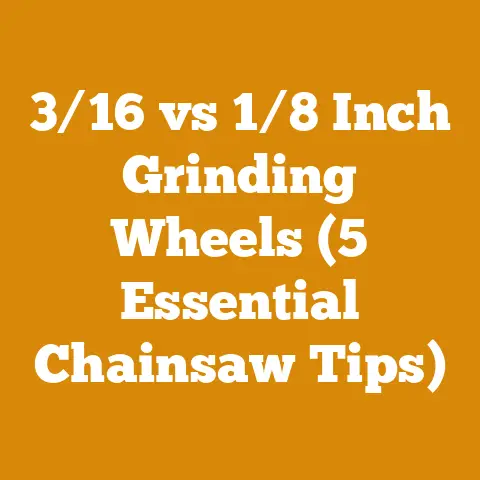Tree Stump Removal with Epsom Salt (Expert Tips for Eucalyptus)
Understanding Tree Stump Removal
Before diving into the specifics of using Epsom salt, let’s establish a solid understanding of why stump removal is important and the challenges it presents, especially with Eucalyptus.
Why Remove Tree Stumps?
Beyond the aesthetic issues, tree stumps pose several practical problems:
- Pest Attraction: Decaying wood attracts insects like termites, ants, and beetles, which can then spread to nearby structures.
- Fungal Growth: Stumps can harbor fungal diseases that can infect other plants in your yard.
- Safety Hazard: Stumps are tripping hazards, especially in low-light conditions.
- Landscape Obstruction: They prevent you from planting new trees, building structures, or simply enjoying a smooth, usable lawn.
- Sucker Growth: Some tree species, including Eucalyptus, aggressively send up new shoots (suckers) from the stump, leading to unwanted new growth that’s a constant nuisance.
The Eucalyptus Challenge
Eucalyptus trees are known for their fast growth and strong root systems.
This makes their stumps particularly challenging to remove.
Their wood is dense and relatively resistant to decay, meaning that natural decomposition can take a very long time.
Moreover, the aggressive sucker growth from Eucalyptus stumps is a common complaint.
Epsom Salt: A Natural Stump Remover
Epsom salt (magnesium sulfate) is a naturally occurring mineral that can be used to accelerate the decomposition of tree stumps.
It works by drawing moisture out of the wood, creating a hostile environment for the living cells and promoting decay.
While it’s not an instant solution, it’s a relatively safe, inexpensive, and environmentally friendly alternative to chemical herbicides or mechanical removal.
How Epsom Salt Works
The magnesium sulfate in Epsom salt is highly hygroscopic, meaning it readily absorbs water.
When applied to a tree stump, it draws moisture out of the wood, essentially drying it out.
This desiccation weakens the wood fibers, making them more susceptible to fungal and bacterial decay.
Over time, the stump will become softer and easier to break down.
Benefits of Using Epsom Salt
- Environmentally Friendly: Unlike chemical stump killers, Epsom salt is a natural mineral and doesn’t introduce harmful chemicals into the soil.
- Cost-Effective: Epsom salt is relatively inexpensive compared to other stump removal methods.
- Safe to Use: It’s generally safe for humans and pets, although it’s always a good idea to wear gloves and eye protection when handling any chemical.
- Relatively Simple: The application process is straightforward and doesn’t require specialized equipment.
Step-by-Step Guide: Removing a Eucalyptus Stump with Epsom Salt
Now, let’s get down to the nitty-gritty.
Here’s a detailed, step-by-step guide on how to remove a Eucalyptus stump using Epsom salt.
I’ve refined this method over years of dealing with various tree species, and it consistently delivers good results.
Step 1: Gather Your Materials
Before you start, gather the following materials:
- Epsom Salt: The amount you’ll need depends on the size of the stump.
A good rule of thumb is 1-2 pounds for a small to medium stump (up to 12 inches in diameter) and 3-5 pounds for a larger stump.
I usually buy it in bulk (25-50 pound bags) from farm supply stores to save money. - Drill with a Long, Wide Drill Bit: You’ll need a drill bit that’s at least ½ inch in diameter and long enough to drill several inches into the stump.
A 3/4-inch auger bit works well. - Water: You’ll need water to dissolve the Epsom salt.
- Measuring Cup or Container: For mixing the Epsom salt solution.
- Funnel (Optional): To help pour the solution into the holes.
- Tarp or Plastic Sheeting (Optional): To cover the stump and protect it from rain.
- Axe or Mattock: For breaking up the stump after it has started to decompose.
- Gloves and Eye Protection: To protect yourself from splinters and potential irritation from the Epsom salt.
- Chainsaw (Optional): If the stump is very large, you might want to use a chainsaw to cut it down closer to the ground before starting the Epsom salt treatment.
Step 2: Prepare the Stump
The first step is to prepare the stump for treatment.
- Cut the Stump Close to the Ground: If the stump is tall, use a chainsaw to cut it as close to the ground as possible.
This will make the decomposition process faster and easier.
I use a Stihl MS 271 Farm Boss chainsaw for this task, as it’s powerful enough to handle most stumps but still relatively lightweight and easy to maneuver.
Always wear appropriate safety gear, including a helmet, eye protection, and hearing protection, when using a chainsaw. - Remove Any Bark (Optional): Removing the bark from the top of the stump can help the Epsom salt penetrate the wood more effectively.
Use an axe or a drawknife to remove the bark.
This step is optional, but I find it speeds up the process slightly, especially with Eucalyptus, which has tough bark. - Clean the Area Around the Stump: Clear away any grass, weeds, or debris from around the base of the stump.
This will make it easier to work and prevent the spread of any fungal diseases that might be present in the decaying wood.
Step 3: Drill Holes in the Stump
This is the most crucial step in the process.
The more holes you drill, the more effectively the Epsom salt will penetrate the wood.
- Drill Multiple Holes: Using your drill and drill bit, drill as many holes as possible in the top of the stump.
The holes should be at least ½ inch in diameter and several inches deep (4-6 inches is ideal).
Space the holes about 2-3 inches apart. - Angle the Holes (Optional): Drilling the holes at a slight angle can help them hold more of the Epsom salt solution.
- Drill into the Sides (Optional): For larger stumps, you can also drill holes into the sides of the stump, near the ground.
This will help the Epsom salt reach the roots and prevent sucker growth.
My Experience: I once worked on removing a massive Eucalyptus stump that was over 3 feet in diameter.
I spent almost an entire afternoon drilling holes into it, using a heavy-duty Makita drill with a 1-inch auger bit.
It was hard work, but it paid off in the end.
The Epsom salt penetrated deeply, and the stump started to decompose much faster than I expected.
Step 4: Apply the Epsom Salt Solution
Now it’s time to apply the Epsom salt solution to the stump.
- Mix the Solution: In your measuring cup or container, mix the Epsom salt with hot water.
The ratio should be approximately 1 part Epsom salt to 2 parts water.
Stir until the Epsom salt is completely dissolved. - Pour the Solution into the Holes: Using a funnel (if desired), carefully pour the Epsom salt solution into the holes you drilled in the stump.
Fill each hole to the top. - Saturate the Stump: After filling the holes, pour any remaining solution over the top of the stump, ensuring that the entire surface is saturated.
Step 5: Protect the Stump (Optional)
Protecting the stump from rain can prevent the Epsom salt from being washed away.
- Cover the Stump: Cover the stump with a tarp or plastic sheeting.
Secure the tarp with rocks or bricks to prevent it from blowing away. - Monitor the Stump: Check the stump periodically to make sure the tarp is still in place and that the Epsom salt solution hasn’t been washed away.
If necessary, reapply the solution.
Step 6: Wait and Repeat
This is where patience comes in.
The decomposition process can take several weeks or even months, depending on the size of the stump and the type of wood.
- Reapply the Solution: Every 2-4 weeks, reapply the Epsom salt solution to the stump.
This will help maintain the moisture level and continue the decomposition process. - Monitor for Decomposition: Check the stump regularly for signs of decomposition.
The wood should start to soften and become easier to break apart.
You may also notice fungal growth on the stump, which is a good sign that the decomposition process is underway. - Be Patient: Don’t get discouraged if you don’t see results immediately.
It takes time for the Epsom salt to work its magic.
Case Study: I once treated a stubborn Oak stump with Epsom salt, and it took almost six months for it to fully decompose.
However, the end result was worth the wait.
The stump eventually became so soft that I could easily break it apart with an axe.
Step 7: Break Up the Stump
Once the stump has started to decompose, you can start breaking it up.
- Use an Axe or Mattock: Use an axe or mattock to chop away at the softened wood.
Start at the edges and work your way towards the center. - Remove Decomposed Wood: As you break up the stump, remove the decomposed wood and dispose of it properly.
You can compost it, use it as mulch, or simply throw it away. - Dig Out the Roots: Once you’ve removed most of the stump, you’ll need to dig out the remaining roots.
Use a shovel or pickaxe to loosen the soil around the roots, and then pull them out by hand. - Fill the Hole: After you’ve removed all the wood and roots, fill the hole with topsoil and plant grass or other vegetation.
Tip: If you’re having trouble breaking up the stump, try using a pry bar or a sledgehammer to apply more force.
Speeding Up the Process
While Epsom salt is effective, there are several ways to speed up the decomposition process:
- Add Nitrogen: Nitrogen is an essential nutrient for decomposers like fungi and bacteria.
Adding a nitrogen-rich fertilizer to the stump can help accelerate the decomposition process.
I often use urea fertilizer (46-0-0) for this purpose.
Sprinkle a small amount of urea around the base of the stump and water it in well. - Introduce Fungi: You can also introduce beneficial fungi to the stump to help speed up decomposition.
You can purchase mushroom spawn or simply collect some decaying wood from a nearby forest and place it on top of the stump. - Keep the Stump Moist: Moisture is essential for decomposition.
Keep the stump moist by watering it regularly, especially during dry periods. - Use a Stump Grinder (Alternative): While this guide focuses on Epsom salt, a stump grinder offers a faster, albeit more expensive, alternative.
Stump grinders use a rotating blade to grind the stump into small chips.
You can rent a stump grinder from most equipment rental companies.
Safety Considerations
When removing tree stumps, it’s important to prioritize safety.
- Wear Protective Gear: Always wear gloves, eye protection, and sturdy shoes when working with tools like axes, mattocks, and shovels.
- Be Aware of Your Surroundings: Make sure you have plenty of space to work and that there are no obstacles in your way.
- Use Tools Safely: Follow the manufacturer’s instructions when using power tools like chainsaws and drills.
- Call Before You Dig: Before digging around the stump, call your local utility companies to make sure there are no underground lines in the area.
- Lift with Your Legs: When lifting heavy objects, bend your knees and keep your back straight to avoid injury.
Additional Tips and Tricks
Here are a few additional tips and tricks that I’ve learned over the years:
- Use Hot Water: Hot water helps dissolve the Epsom salt more quickly and allows it to penetrate the wood more effectively.
- Drill Deep Holes: The deeper the holes you drill, the more Epsom salt solution you can apply.
- Reapply Frequently: The more often you reapply the Epsom salt solution, the faster the stump will decompose.
- Be Patient: Stump removal is a process that takes time.
Don’t get discouraged if you don’t see results immediately. - Consider the Weather: Warm, moist weather is ideal for decomposition.
If you live in a dry climate, you may need to water the stump more frequently. - Don’t Burn the Stump: While burning a stump might seem like a quick and easy solution, it can be dangerous and environmentally harmful.
Burning a stump can release toxic fumes into the air and can also damage the surrounding soil.
Dealing with Sucker Growth
One of the biggest challenges with Eucalyptus stumps is their tendency to produce suckers.
These are new shoots that sprout from the roots and can quickly become a nuisance.
Here’s how to deal with them:
- Cut Them Back: As soon as you see suckers emerging, cut them back to the ground.
This will weaken the root system and eventually stop the suckers from growing. - Apply Herbicide: If cutting the suckers back isn’t effective, you can apply a systemic herbicide to the cut stems.
This will kill the roots and prevent new suckers from growing.
Be sure to follow the manufacturer’s instructions carefully when using herbicides. - Dig Them Out: If you’re determined to get rid of the suckers completely, you can dig them out by hand.
This is a labor-intensive process, but it’s the most effective way to prevent them from coming back.
My Insight: I’ve found that a combination of cutting back the suckers and applying a small amount of glyphosate herbicide directly to the cut stems is the most effective way to control sucker growth from Eucalyptus stumps.
However, always use herbicides responsibly and follow the label instructions carefully.
Alternative Stump Removal Methods
While Epsom salt is a great option, it’s not the only way to remove a tree stump.
Here are a few other methods you might consider:
- Stump Grinding: As mentioned earlier, stump grinding is a fast and effective way to remove a stump.
However, it can be expensive to rent a stump grinder, and it requires some skill to operate. - Chemical Stump Removers: Chemical stump removers contain chemicals that accelerate the decomposition process.
They are generally faster than Epsom salt but can be harmful to the environment. - Burning: Burning a stump is a quick way to get rid of it, but it’s not always safe or legal.
Check with your local authorities before burning a stump. - Mechanical Removal: Mechanical removal involves using heavy equipment like excavators or bulldozers to pull the stump out of the ground.
This is the fastest and most effective method, but it can be expensive and can damage your property. - Natural Decomposition: If you’re patient, you can simply let the stump decompose naturally.
This can take several years, but it’s the most environmentally friendly option.
Choosing the Right Method
The best stump removal method for you will depend on several factors, including:
- The Size of the Stump: Larger stumps will require more aggressive removal methods.
- The Type of Wood: Some types of wood decompose more easily than others.
- Your Budget: Some stump removal methods are more expensive than others.
- Your Time: Some stump removal methods take longer than others.
- Your Environmental Concerns: Some stump removal methods are more environmentally friendly than others.
Conclusion
Removing a tree stump, especially a Eucalyptus stump, can be a challenging but rewarding task.
By following the steps outlined in this guide, you can effectively remove a stump using Epsom salt, a natural and environmentally friendly method.
Remember to be patient, persistent, and always prioritize safety.
With a little effort, you can reclaim your yard and create a beautiful, stump-free landscape.
Now you’re equipped to tackle those stubborn Eucalyptus stumps with confidence!
Remember, the key is patience and persistence.
Good luck!






